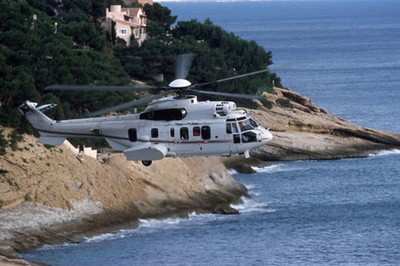Sun, Jun 01, 2008
Eurocopter Increases Research Into Environmentally-Friendly
Helos
 One of the world's leading
helicopter manufacturer is determined to develop the greenest
possible range of aircraft -- as recent research activities
show.
One of the world's leading
helicopter manufacturer is determined to develop the greenest
possible range of aircraft -- as recent research activities
show.
For several years, Eurocopter has carried out research as part of
the Optimal and Friendcopter program primarily concerned with the
reduction of noise pollution.
Research has determined this can be done through reduction of
aerodynamic noise through the development of active noise control
systems for main rotors and reduction of engine noise through
studies on engine integration, the shape, position and design of
tail pipes and the air intake.
Significant efforts are also being devoted to developing quieter
flight procedures. A major flight test campaign was performed with
an EC130 in 2007 to test a wide array of situations –
including takeoffs, approaches and cruising. This work earned the
team international recognition in the form of the Cheeseman prize
for ‘best helicopter-related technical publication’,
which was presented at last year’s European Rotorcraft Forum
in Kazan, Russia and at the American Helicopter Society Forum in
Montreal, Canada. Similar tests are currently being conducted using
an EC135 and are being accompanied by the development of a software
tool called HELENA (HELicopter Environmental Noise Analysis) that
predicts noise footprints and will help to define procedures that
can be adapted to every helicopter type.
Eurocopter is playing a major role in the European Clean Sky
program, which was officially launched on 5 February 2008, and
which is of interest to the entire aeronautical industry. Clean Sky
has defined six research platforms or ITDs (Integrated Technology
Demonstrators), including the Green Rotorcraft platform, which is
specifically devoted to helicopters and tilt-rotor aircraft.
Certain research activities also cross over: the Systems for Green
Operations ITD covers electrical power systems; the Eco-Design ITD
concerns the complete industrial cycle; and part of the Sustainable
and Green Engines ITD focuses on the design of turbine engines for
helicopters.
All of this research work aims to reduce greenhouse gas
emissions -- through reductions in fuel consumption -- to reduce
noise and to create a green product life cycle; from manufacturing
until the aircraft is recycled at the end of its service life. To
ensure this green life cycle, Eurocopter’s aims to comply as
fully and as quickly as possible with REACH, a European Community
regulation, which aims to restrict the use of harmful chemical or
toxic substances throughout the helicopter maintenance and
production processes.

In addition to the work on aircraft design, further research
will focus on the operational use of helicopters, developing means
for crews to optimize trajectories and favor quieter and more
energy-efficient flight conditions.
More News
“While legendary World War II aircraft such as the Corsair and P-51 Mustang still were widely flown at the start of the Korean War in 1950, a new age of jets rapidly came to >[...]
Decision Altitude (DA) A specified altitude (mean sea level (MSL)) on an instrument approach procedure (ILS, GLS, vertically guided RNAV) at which the pilot must decide whether to >[...]
Aero Linx: National Aviation Safety Foundation (NASF) The National Aviation Safety Foundation is a support group whose objective is to enhance aviation safety through educational p>[...]
Also: Cal Poly Aviation Club, $$un Country, Arkansas Aviation Academy, Teamsters Local 2118 In response to two recent general aviation accidents that made national headlines, more >[...]
“The FAA is tasked with ensuring our skies are safe, and they do a great job at it, but there is something about the system that is holding up the medical process. Obviously,>[...]
 Aero-News: Quote of the Day (04.28.25)
Aero-News: Quote of the Day (04.28.25) ANN's Daily Aero-Term (04.28.25): Decision Altitude (DA)
ANN's Daily Aero-Term (04.28.25): Decision Altitude (DA) ANN's Daily Aero-Linx (04.28.25)
ANN's Daily Aero-Linx (04.28.25) Airborne-Flight Training 04.24.25: GA Refocused, Seminole/Epic, WestJet v TFWP
Airborne-Flight Training 04.24.25: GA Refocused, Seminole/Epic, WestJet v TFWP Aero-News: Quote of the Day (04.29.25)
Aero-News: Quote of the Day (04.29.25)



